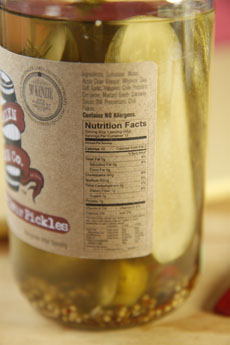

Ready, set, taste! Photo by Elvira Kalviste | THE NIBBLE.
|
STEPHANIE ZONIE is a contributing editor at THE NIBBLE.
|
|
November 2013
|
 |
Tips For Buying Pickles
Page 7: Conclusions & Advice For Pickle Fans
This is Page 7 of a seven-page article, plus six pages of reviews of artisan pickle brands. On this page: tips for buying pickles. Click on the black links below to visit other pages.
Now comes the tough part: tasting hundreds of pickles.
Pickle Tasting Protocol
- All pickles were tasted cold.
- No more than four different pickles were tasted in one sitting.
- After each pickle was evaluated, a bite of a plain cracker (with an unsalted top) was taken, and water was drunk. At least three minutes were then allowed to elapse before another pickle was tasted.
- While we tried to taste all pickles of one type at one sitting (dill, sour, bread & butter, etc.) this was not always possible.
- It was also not always possible to taste all of the pickles produced by one manufacturer.
|
|

Water biscuits: a taster’s best friend. Photo courtesy PantryPacker.com.au. |
Pickle Tasting Party
I conducted my tasting at home. However, at THE NIBBLE’s offices, where the individual brands were photographed, a separate pickle tasting was conducted.
They turned it into a party, serving the pickles as a casual dinner with:
- Bread and butter
- Charcuterie, cheeses and wrap sandwiches (sliced)
- Wine
- Sparkling water with bitters
Conclusions & Pickle Buying Tips
Many pickles later, here are our observations. Brand reviews begin on the next page.
- There are many businesses making perfectly decent pickles in this country, but a truly outstanding pickle, one that has balanced flavor elements and a level of crunch appropriate for its type, is not that easy to find. Favorites and runners up are so noted. While tasting, we came to have a great appreciation for those pickle manufacturers who go full out to make their products. I’m talking about the people who use real herbs and spices instead of flavorings, sweeteners like sugar or honey or maple syrup instead of corn syrup or HFCS, and no preservatives or food colors.
- Visible herbs/spices in a jar are not a guarantee of good quality pickles. Many pickles have at least a modest quantity of herbs/spices in their brine—so many, in fact, that it’s not always mentioned in the evaluations. They look very appetizing indeed, especially when you see big chunks of garlic or peppers or fresh dill or mustard seed. Manufacturers are well aware that people taste first with their eyes. There are some wonderful pickles being made that include herbs/spices in their jars, but there are others that are “all show and no go.” They rely on appearance to get you to buy them, but they are not memorable in taste.
| 3. |
Not all pickles have nutrition information on their labels. If a manufacturer sells under a certain volume of product annually (10,000 units per flavor/SKU), they are not required to have this information. That’s because nutrition assays, done by a third-party lab, are expensive; it can be a hardship for small-scale manufacturers to pay for them. If it is important to you to know precisely how much sodium or how many calories or grams of sugar are in a serving, contact the manufacturer before buying, or stick to pickles that have nutrition information on their label. |

Photo by Elvira Kalviste | THE NIBBLE. |
| 4. |
The ingredient label is not always reliable. In several instances, we ran across undeclared ingredients in pickles. We found examples of sugar, salt, black peppercorns and chili peppers that were obviously present in various jars of pickles, yet not mentioned on the ingredient label. Given how serious people are about food sensitivities these days, this is not a small matter. While one manufacturer seemed indifferent when I pointed this out, others told me that they knew about this and were working to resolve it. In one case, an ingredient label made for a manufacturer had been cut short at one edge by the printer, removing chili peppers from the ingredient list. There doesn’t seem to be a simple way around this, except to advise that if you have food sensitivities, you taste with caution initially.
|
| 5. |
Pickles are processed foods, and may have unwanted additives. Are there additives to which we don’t object? Sure. A bit of calcium chloride or alum to preserve a pickle’s crispness isn’t going to do a lot of harm. But there are so many questionable ingredients in processed foods these days; is it really necessary to add to the amount most of us ingest, when there are plenty of pickle makers producing equally good products that don’t use preservatives or food colorings or flavorings?
|
| 6. |
Fermented pickles rock. We came to have a great appreciation for fermented pickles. They aren’t as easy to find as are the fresh process type, but they have a very different quality. All pickles were once made this way, so, if you haven’t tried genuine fermented pickles, search out some and bite into a true piece of food history.
|

|







